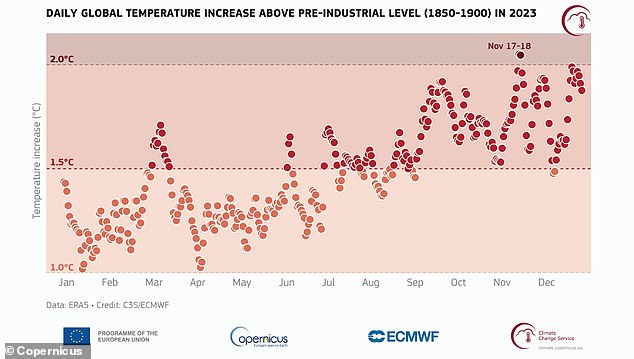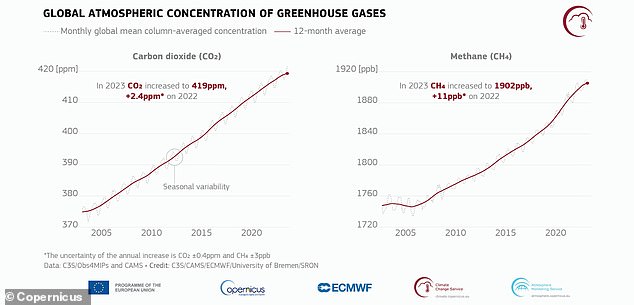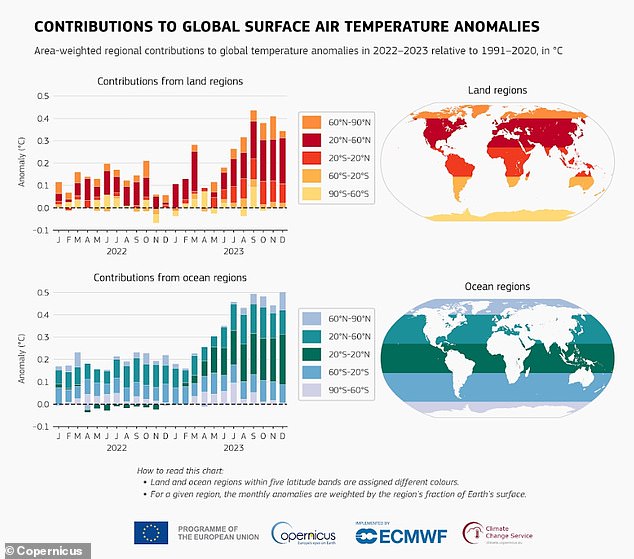2023 was officially the hottest year on record – with global temperatures close to 1.5°C, scientists warn
The department's measurements refer to the average air temperature for the entire planet over the entire year – so lower than a single typical 'hot' temperature measurement.

Scientists are increasingly linking extreme weather events to planetary warming, which is largely caused by CO2 emissions from fossil fuels. For example, warmer air can hold more moisture, which means more intense rainfall and flooding. Pictured, a man pulls a bag of goods recovered from a building as he wades through water on August 5, 2023 in Zhuozhou, Hebei province, south of Beijing, China


A man cools down at a temporary misting station deployed by the city in the Downtown Eastside due to a heat wave, in Vancouver, British Columbia, August 16, 2023


For Britons, the new record may be hard to believe as the country was hit by cold air and rain for much of the summer, despite heatwaves in mainland Europe. However, CS3 provides an average for the year for the entire world, so colder than normal conditions in one country don't tell the whole story. Holidaymakers are pictured on the beach in Weymouth, Dorset, on July 31, 2023
Not only was 2023 the warmest year on record, but it also marks the first time that every day within a year is 1.8°F (1°C) above the “pre-industrial” average (the average between 1850 and 1900) .
In fact, almost half of the 365 days in 2023 were more than 1.5°C warmer than the 1850-1900 level, while two days in November were more than 2°C warmer than the 1850-1900 level for the first time . C) warmer.
This is worrying because it is a global goal to keep global average temperatures within 2°C and if possible 1.5°C as part of the Paris Agreement, a binding climate treaty signed in 2016.
Fortunately, the news does not mean that we have exceeded the limits of the Paris Agreement (as they refer to periods of at least 20 years in which this average temperature deviation is exceeded), but the new record for 2023 'sets a terrible precedent'.
“The extremes we have observed in recent months are dramatic evidence of how far we are now from the climate in which our civilization developed,” said Carlo Buontempo, director of C3S.
“This has profound implications for the Paris Agreement and all human endeavors.”


A Canadair firefighting plane sprays water during a fire in Dervenochoria, northwest of Athens, on July 19, 2023


A woman cools herself with a fan due to high temperatures in Rome, July 18, 2023


In 2023, two days in November (17 and 18) were more than 2°C warmer than the 'pre-industrial' average for the first time


Atmospheric concentrations of carbon dioxide and methane (the two major greenhouse gases) continued to rise, reaching record levels in 2023
2023 set the record for the hottest year on record, largely due to 'unprecedented' global temperatures from June onwards, fueled mainly by greenhouse gases.
Atmospheric concentrations of carbon dioxide and methane (the two main greenhouse gases) continued to rise, reaching record levels in 2023.
Furthermore, every month from June to December in 2023 was warmer than the corresponding month in any year.
Several months of 2023 were the hottest on record for that specific month, such as September, November and December, as well as July (not only the hottest July on record, but also the hottest month on record).
Looking at Europe separately from the rest of the world, 2023 was the second warmest year on record, after 2020.
In Europe, last year was 0.17°C cooler than 2020 (the hottest year on record in Europe), but temperatures were still above average for eleven months of 2023.
CS3's main metric for measuring how warm it is is the temperature of the air, but it also tracks the temperatures of the world's oceans.


Surface air temperatures are usually the main metric looked at when assessing temperature increases, but ocean temperatures are also important indicators.
It looks at sea surface temperature – how hot the water is close to the ocean surface.
Unfortunately, new records were also recorded here for 2023, with 'persistent and unusually high' sea surface temperature anomalies.
Global mean sea surface temperature (SST) reached record levels from April through December, while August had the highest global monthly mean sea surface temperature on record at 69.76 °F (20.98 °C).
In addition to greenhouse gases, experts blame the El Niño Southern Oscillation (ENSO) for the high ocean temperatures.
ENSO is a pattern of natural climate variability in which ocean temperatures in the central and eastern tropical Pacific Ocean alternate between cooler (La Niña) and warmer (El Niño) than average conditions – affecting temperatures and weather worldwide.
However, the transition to El Niño alone will not explain the entire increase in global ocean surface temperatures in 2023, CS3 says.
With the dependence on fossil fuels for energy generation continuing into 2024, there is every possibility that this year the 2023 record could be broken.
“To successfully manage our climate risk portfolio, we must urgently decarbonize our economy while using climate data and knowledge to prepare for the future,” Buontempo said.
